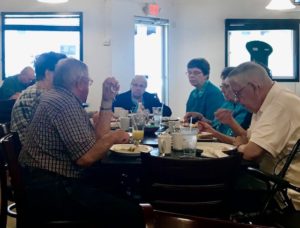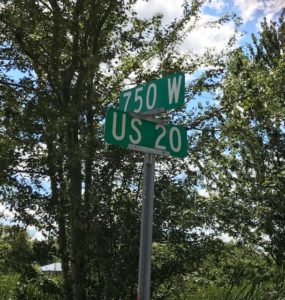Route 20 Report #2
What lies between the coasts? That question is at the heart of this 3,365-mile trek, Pacific to Atlantic, along Route 20. It is now the end of day 14, and I am writing this sitting in a tent in a campground on the shores of Lake Erie. The sunset over the lake was vermillion. The crickets have started in. Every 30 seconds an acorn drops from a tree. I can hear a train way off in the distance.
I was born on one coast, and I’ve made my life on the other. Before this trip, I was not ignorant of what lay between west and east. I had put in time in the Midwest. I had crisscrossed the country on I-80, I-90 and I-40 at various times in my life.
But then 2016 happened. And, like so many people, I all of a sudden didn’t think I knew my own country anymore. So that’s what this trip is about.
I’m discovering too much to write about here. And my ah-ha moments come and go, from attempting to understand gun culture to thinking about the meaning of family to wrapping my head around the place of corn in U.S. agriculture—and I don’t mean “sweet corn.” I mean corn used for ethanol, corn used for high fructose corn syrup, mono-culture, endless fields of it.
But one simple (maybe self-evident) thing I’ve discovered is that small towns (that is, most of the towns along Route 20) are more alike than not, whether they be Shelley, Idaho, or Thermopolis, Wyoming; Rushville, Nebraska or Elizabeth, Illinois; or (today) Westfield, New York. The places you never heard of. The places you would never visit unless your great aunt lived there. Some are more prosperous than others. Some are more beautiful than others. All are pretty proud of themselves. All are populated by people who mean no harm (speaking as the white, traveling-through person I am, you understand). The people seem genuinely friendly. They seem to care deeply about each other. The kids—contrary to what I thought—choose to STAY. They all have newspapers, most dating back to the late 1800s. In the cafes, they play the same country music.
 (Celebrating Selma’s 92nd birthday.
(Celebrating Selma’s 92nd birthday.
Breakfast at Friendly Corner, Laurel, Nebraska)







4 comments
Interesting observations here, but particularly about the kids wanting to stay. Eager to here more about that.
Came as a surprise to me. The artistically tattooed 30-something in Thermopolis, the chopped haired/ red streak waitress in Rushville…they knew what was out there. They chose to live close to their families.
And are the towns more or less homogeneous? If so, I wonder – do the kids choose to stay to avoid encountering difference? If they leave (e.g. for education) do they return?
So interesting.
The towns are racially homogeneous, absolutely. Before the trip, I would have thought the young people didn’t move away (even those who went to college hurried back) because of fear. I am sure that is true with some. The 20 and 30-somethings I talked with in these small towns always answered, without a pause: “I came back/ I live here because this is where my family lives.” Maybe that’s code. But I felt it was sincere.
Leave a Comment